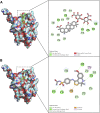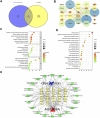Micro-simulation insights into the functional and mechanistic understanding of glycyrrhizin against asthma
- PMID: 37711178
- PMCID: PMC10497961
- DOI: 10.3389/fphar.2023.1220368
Micro-simulation insights into the functional and mechanistic understanding of glycyrrhizin against asthma
Abstract
Asthma is a common chronic respiratory disease, which causes inflammation and airway stenosis, leading to dyspnea, wheezing and chest tightness. Using transgelin-2 as a target, we virtually screened the lead compound glycyrrhizin from the self-built database of anti-asthma compounds by molecular docking technology, and found that it had anti-inflammatory, anti-oxidative and anti-asthma pharmacological effects. Then, molecular dynamics simulations were used to confirm the stability of the glycyrrhizin-transgelin-2 complex from a dynamic perspective, and the hydrophilic domains of glycyrrhizin was found to have the effect of targeting transgelin-2. Due to the self-assembly properties of glycyrrhizin, we explored the formation process and mechanism of the self-assembly system using self-assembly simulations, and found that hydrogen bonding and hydrophobic interactions were the main driving forces. Because of the synergistic effect of glycyrrhizin and salbutamol in improving asthma, we revealed the mechanism through simulation, and believed that salbutamol adhered to the surface of the glycyrrhizin nano-drug delivery system through hydrogen bonding and hydrophobic interactions, using the targeting effect of the hydrophilic domains of glycyrrhizin to reach the pathological parts and play a synergistic anti-asthmatic role. Finally, we used network pharmacology to predict the molecular mechanisms of glycyrrhizin against asthma, which indicated the direction for its clinical transformation.
Keywords: asthma; glycyrrhizin; mechanism; simulation; transgelin-2.
Copyright © 2023 Qi, Xu, Wang, Cai, Wang and Zhou.
Conflict of interest statement
The authors declare that the research was conducted in the absence of any commercial or financial relationships that could be construed as a potential conflict of interest.
Figures





Similar articles
-
Discovery of zolinium TSG1180 as a novel agonist of transgelin-2 for treating asthma.Biomed Pharmacother. 2023 Nov;167:115556. doi: 10.1016/j.biopha.2023.115556. Epub 2023 Sep 29. Biomed Pharmacother. 2023. PMID: 37778269
-
Molecular dynamics study on the behavior and binding mechanism of target protein Transgelin-2 with its agonist TSG12 for anti-asthma drug discovery.Comput Biol Med. 2023 Feb;153:106515. doi: 10.1016/j.compbiomed.2022.106515. Epub 2022 Dec 31. Comput Biol Med. 2023. PMID: 36610217
-
Protective effects of glycyrrhizin against β₂-adrenergic receptor agonist-induced receptor internalization and cell apoptosis.Biol Pharm Bull. 2011;34(5):609-17. doi: 10.1248/bpb.34.609. Biol Pharm Bull. 2011. PMID: 21532146
-
Glycyrrhizin as a promising kryptonite against SARS-CoV-2: Clinical, experimental, and theoretical evidences.J Mol Struct. 2023 Mar 5;1275:134642. doi: 10.1016/j.molstruc.2022.134642. Epub 2022 Nov 25. J Mol Struct. 2023. PMID: 36467615 Free PMC article. Review.
-
ABCs of Asthma.Clin Cornerstone. 2008;8(4):9-25. doi: 10.1016/s1098-3597(08)80010-5. Clin Cornerstone. 2008. PMID: 18713655 Review.
References
-
- Apanasenko I. E., Selyutina O. Y., Polyakov N. E., Suntsova L. P., Meteleva E. S., Dushkin A. V., et al. (2015). Solubilization and stabilization of macular carotenoids by water soluble oligosaccharides and polysaccharides. Arch. Biochem. Biophys. 572, 58–65. 10.1016/j.abb.2014.12.010 - DOI - PMC - PubMed
LinkOut - more resources
Full Text Sources

